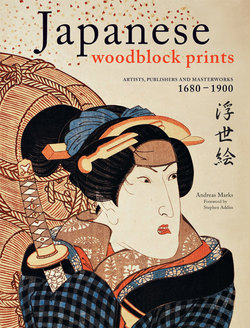Читать книгу Japanese Woodblock Prints - Andreas Marks - Страница 33
На сайте Литреса книга снята с продажи.
ОглавлениеEishi
1756–1829
Family names: Fujiwara, Hosoda. Given names: Tokitomi, Yasaburō. Art names: Chōbun, Chōbunsai, Kaei, Dokuyū.
Eishi was born in 1756 into a high-ranking samurai family living from a generous stipend of 500 koku of rice. Eishi’s family belonged to the Fujiwara clan and their records went back to the tenth century. He was 15 or 16 years old when his father, Hosoda Tokiyuki (1737–1772), died and Eishi became the head of the family. In 1781, he received a position in the palace of the shogun, presumably within the department of keeping coloring materials.
It is not clear when and under which circumstances Eishi started to study painting. Apparently he first studied painting under Kanō Eisen’in Michinobu (1730–1790). Unusual amongst print artists, Eishi served the shogun Tokugawa Ieharu (1737–1786) who allegedly gave him his artist name Eishi. However, it seems more likely that Eishi received his name from his teacher Kanō Michinobu.
Presumably because of health issues, Eishi left his official position in 1784 but remained in the service of the shogun. He turned to print design and became the student of a certain Torii Bunryūsai (second half eighteenth century) about whom nothing else is known. His earliest work is dated from 1785. In 1789, Eishi retired from the service to the shogun and passed the leadership of the family on to his adopted son Tokitoyo. The reason for the change might lie in the new anti-luxury laws that were imposed at that time, aiming also at ukiyo-e.
Initially influenced by Kiyonaga, he became a rival to Utamaro and established his own school. Eishi specialized in idealized portraits of beautiful women in an elegant and refined style. The beauty prints were mainly issued in series, usually by the publishers Nishimuraya Yohachi or Iwatoya Kisaburō. The figure on the far right of the next page illustrates the series “Beauties of the Yoshiwara as Six Floral Saints” (Seirō bijin rokkasen), one of well over thirty series produced by Nishimuraya. Most of the prints by Eishi are in theōban format popular at that time, but there is also a small number of pillar prints.
During the short period when Eishi was active as a print designer, from 1785 until 1801, Eishi created also a few illustrations for books including some erotica. He then stopped designing prints and only did paintings for which he is considered as one of the best artists with an enormous output. In 1800, one of his paintings was added to the collection of the retired empress Go-Sakuramachi (1740-1813) which might be the reason why he stopped designing prints. Around the same time he received the honorary title Jibukyō, possibly also in relation to the success of his painting.
Eishi had a small number of students but he seemed not to have operated his own school or a large studio. Several of his students are only known by name and their prints or paintings are rare if not unknown today. Amongst his better known students are Eishō and Eiri.
Eishi died on the second day of the seventh month 1829, aged 73. He is buried at the Rengeji Temple and his posthumous Buddhist name is Kōsetsuin Denkaishin Eishi Nichizui Koji.
c.1792 Eleven women and a young assistant writing poems. ōban triptych. Publisher: Nishimuraya Yohachi. Collection Peter Rieder. Brandt 1977, cat. I.123.
early 1790s The courtesan Hanaōgi of the ōgiya. Hashira-e. Publisher: Nishimuraya Yohachi. Library of Congress. Brandt 1977, cat. I.224, and Pins 1982, fig. 855.
c.1794 The courtesan Morokoshi of the Echizenya, from the series “Beauties of the Green Houses as Six Floral Saints” (Seirō bijin rokkasen). ōban. Publisher: Nishimuraya Yohachi. Asian Art Museum, National Museums in Berlin. Brandt 1977, cat. I.169.
